Page 3 of 424
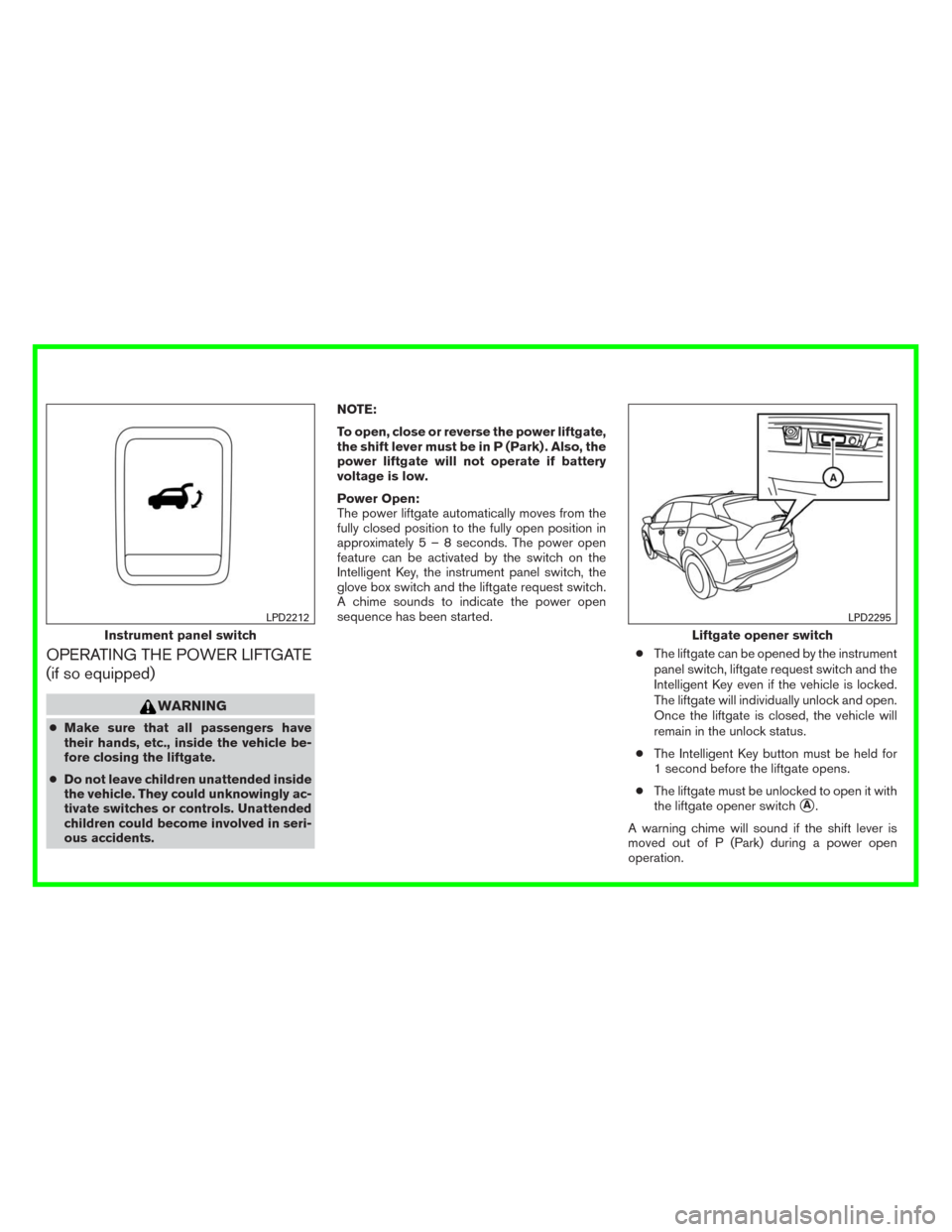
OPERATING THE POWER LIFTGATE
(if so equipped)
WARNING
●Make sure that all passengers have
their hands, etc., inside the vehicle be-
fore closing the liftgate.
●Do not leave children unattended inside
the vehicle. They could unknowingly ac-
tivate switches or controls. Unattended
children could become involved in seri-
ous accidents.NOTE:
To open, close or reverse the power liftgate,
the shift lever must be in P (Park) . Also, the
power liftgate will not operate if battery
voltage is low.
Power Open:
The power liftgate automatically moves from the
fully closed position to the fully open position in
approximately5–8seconds. The power open
feature can be activated by the switch on the
Intelligent Key, the instrument panel switch, the
glove box switch and the liftgate request switch.
A chime sounds to indicate the power open
sequence has been started.
●The liftgate can be opened by the instrument
panel switch, liftgate request switch and the
Intelligent Key even if the vehicle is locked.
The liftgate will individually unlock and open.
Once the liftgate is closed, the vehicle will
remain in the unlock status.
●The Intelligent Key button must be held for
1 second before the liftgate opens.
●The liftgate must be unlocked to open it with
the liftgate opener switch
�A.
A warning chime will sound if the shift lever is
moved out of P (Park) during a power open
operation.
Instrument panel switch
LPD2212
Liftgate opener switch
LPD2295
Page 16 of 424
1. Front view camera (if so equipped)(P. 4-12)
2. Engine hood (P. 3-22)
3. Windshield wiper and washer switch,
wiper blades (P. 2-27, 8-19)
4. Windshield (P. 8-19)
5. Rearview mirror (P. 3-32)
6. Power windows (P. 2-45)
7. Door locks, NISSAN Intelligent Key®,
keys (P. 3-4, 3-2)
8. Mirrors (P. 3-32)
9. Side view camera (if so equipped)
(P. 4-12)
10. Tire pressure (P. 8-29)
11. Flat tire (P. 6-3)
12. Tire chains (P. 8-36)
13. Fog light switch (if so equipped)
(P. 2-30)
14. Replacing bulbs (P. 8-27)
15. Headlight and turn signal switch
(P. 2-30)
Refer to the page number indicated in pa-
rentheses for operating details.
LII2225
EXTERIOR FRONT
Illustrated table of contents0-3
Page 17 of 424
1. Antenna (P. 4-29)
2. Rear window wiper and washer switch(P. 2-29)
3. Liftgate release (P. 3-22)
4. Rearview camera (P. 4-2)
5. Replacing bulbs (P. 8-27)
6. Fuel-filler door (P. 3-27)
7. Fuel-filler cap, fuel recommendation
(P. 3-27, P. 9-2 )
8. Child safety rear door lock (P. 3-4)
Refer to the page number indicated in pa-
rentheses for operating details.
LII2222
EXTERIOR REAR
0-4Illustrated table of contents
Page 22 of 424
Warninglight Name Page
or
Anti-lock Braking
System (ABS) warn-
ing light 2-8
or
Brake warning light 2-8
Charge warning
light
2-8
Engine oil pressure
warning light2-8
Forward Emergency
Braking system
warning light (if so
equipped)2-9
Low tire pressure
warning light
2-9
Warning
light Name Page
Low windshield-
washer fluid warning
light 2-11
Master warning light 2-11
Power steering
warning light
2-11
Seat belt warning
light and chime2-11
Supplemental air
bag warning light2-12
Indicator
light Name Page
Front fog light indi-
cator light (if so
equipped) 2-12
Front passenger air
bag status light
2-12
Indicator
light Name Page
High beam indicator
light (blue) 2-12
Malfunction Indica-
tor Light (MIL)2-12
Security indicator
light2-13
Side light and head-
light indicator light
(green)2-13
Slip indicator light 2-13
Turn signal/hazard
indicator lights
2-13
Vehicle Dynamic
Control (VDC) off
indicator light2-14
WARNING/INDICATOR LIGHTS
Illustrated table of contents0-9
Page 25 of 424
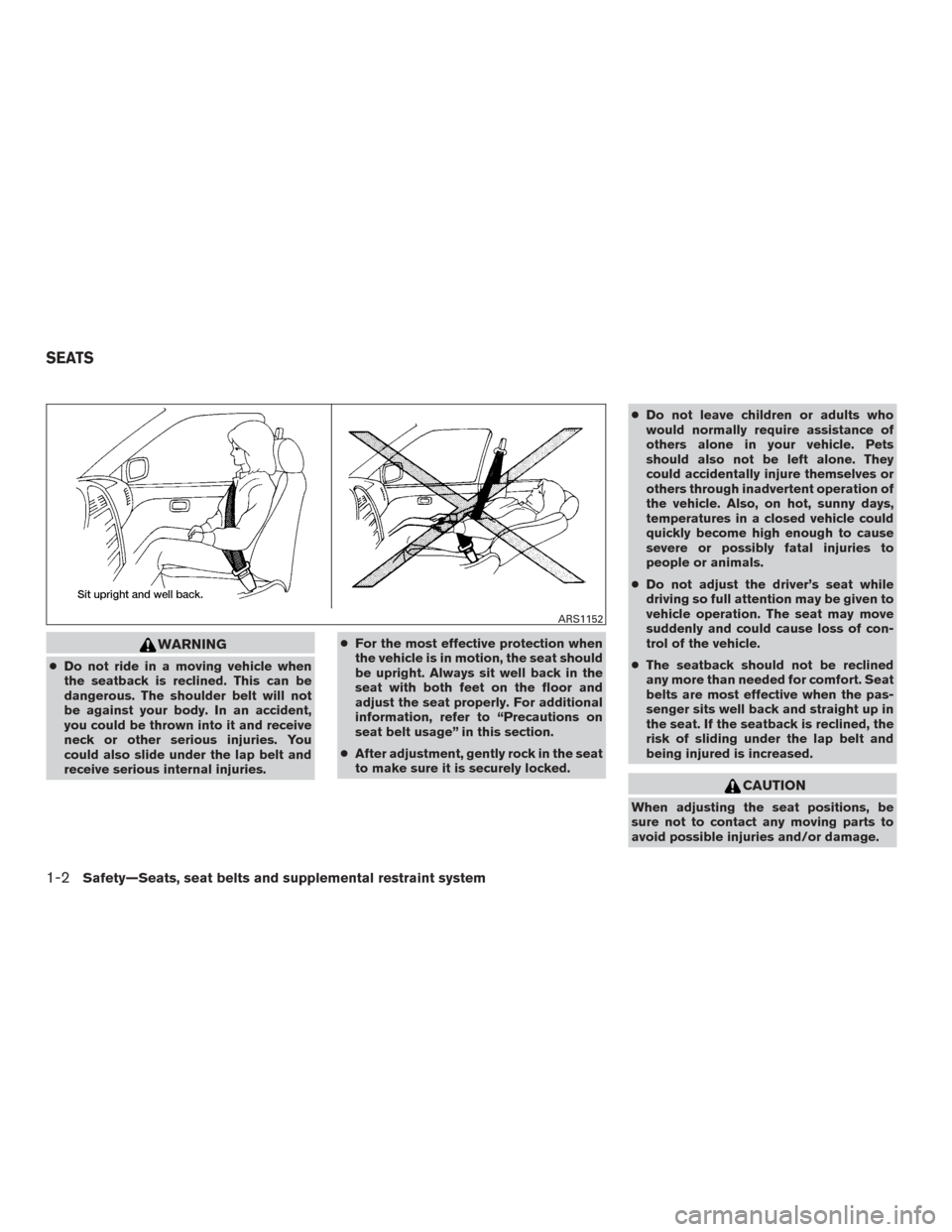
WARNING
●Do not ride in a moving vehicle when
the seatback is reclined. This can be
dangerous. The shoulder belt will not
be against your body. In an accident,
you could be thrown into it and receive
neck or other serious injuries. You
could also slide under the lap belt and
receive serious internal injuries. ●
For the most effective protection when
the vehicle is in motion, the seat should
be upright. Always sit well back in the
seat with both feet on the floor and
adjust the seat properly. For additional
information, refer to “Precautions on
seat belt usage” in this section.
● After adjustment, gently rock in the seat
to make sure it is securely locked. ●
Do not leave children or adults who
would normally require assistance of
others alone in your vehicle. Pets
should also not be left alone. They
could accidentally injure themselves or
others through inadvertent operation of
the vehicle. Also, on hot, sunny days,
temperatures in a closed vehicle could
quickly become high enough to cause
severe or possibly fatal injuries to
people or animals.
● Do not adjust the driver’s seat while
driving so full attention may be given to
vehicle operation. The seat may move
suddenly and could cause loss of con-
trol of the vehicle.
● The seatback should not be reclined
any more than needed for comfort. Seat
belts are most effective when the pas-
senger sits well back and straight up in
the seat. If the seatback is reclined, the
risk of sliding under the lap belt and
being injured is increased.
CAUTION
When adjusting the seat positions, be
sure not to contact any moving parts to
avoid possible injuries and/or damage.
ARS1152
SEATS
1-2Safety—Seats, seat belts and supplemental restraint system
Page 26 of 424
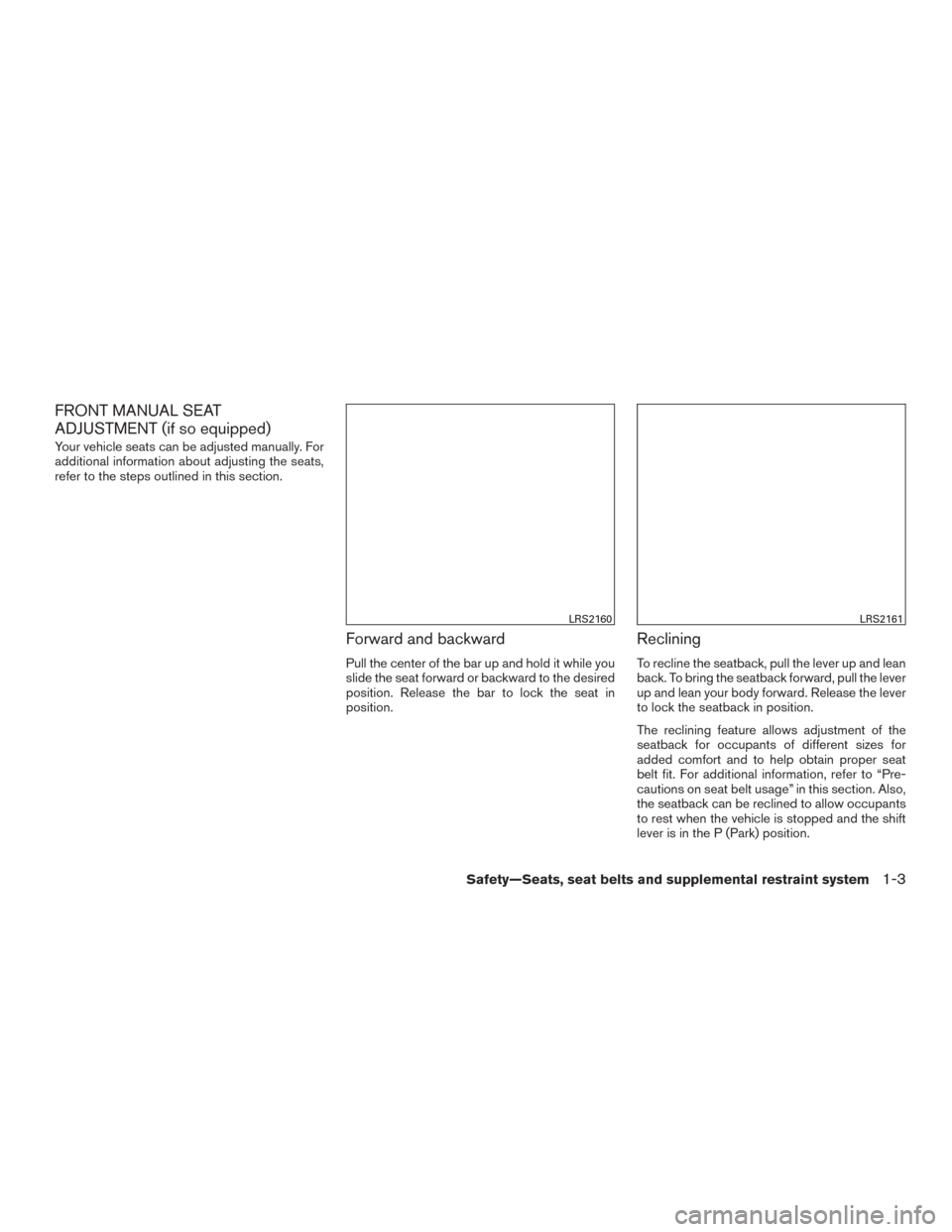
FRONT MANUAL SEAT
ADJUSTMENT (if so equipped)
Your vehicle seats can be adjusted manually. For
additional information about adjusting the seats,
refer to the steps outlined in this section.
Forward and backward
Pull the center of the bar up and hold it while you
slide the seat forward or backward to the desired
position. Release the bar to lock the seat in
position.
Reclining
To recline the seatback, pull the lever up and lean
back. To bring the seatback forward, pull the lever
up and lean your body forward. Release the lever
to lock the seatback in position.
The reclining feature allows adjustment of the
seatback for occupants of different sizes for
added comfort and to help obtain proper seat
belt fit. For additional information, refer to “Pre-
cautions on seat belt usage” in this section. Also,
the seatback can be reclined to allow occupants
to rest when the vehicle is stopped and the shift
lever is in the P (Park) position.
LRS2160LRS2161
Safety—Seats, seat belts and supplemental restraint system1-3
Page 29 of 424
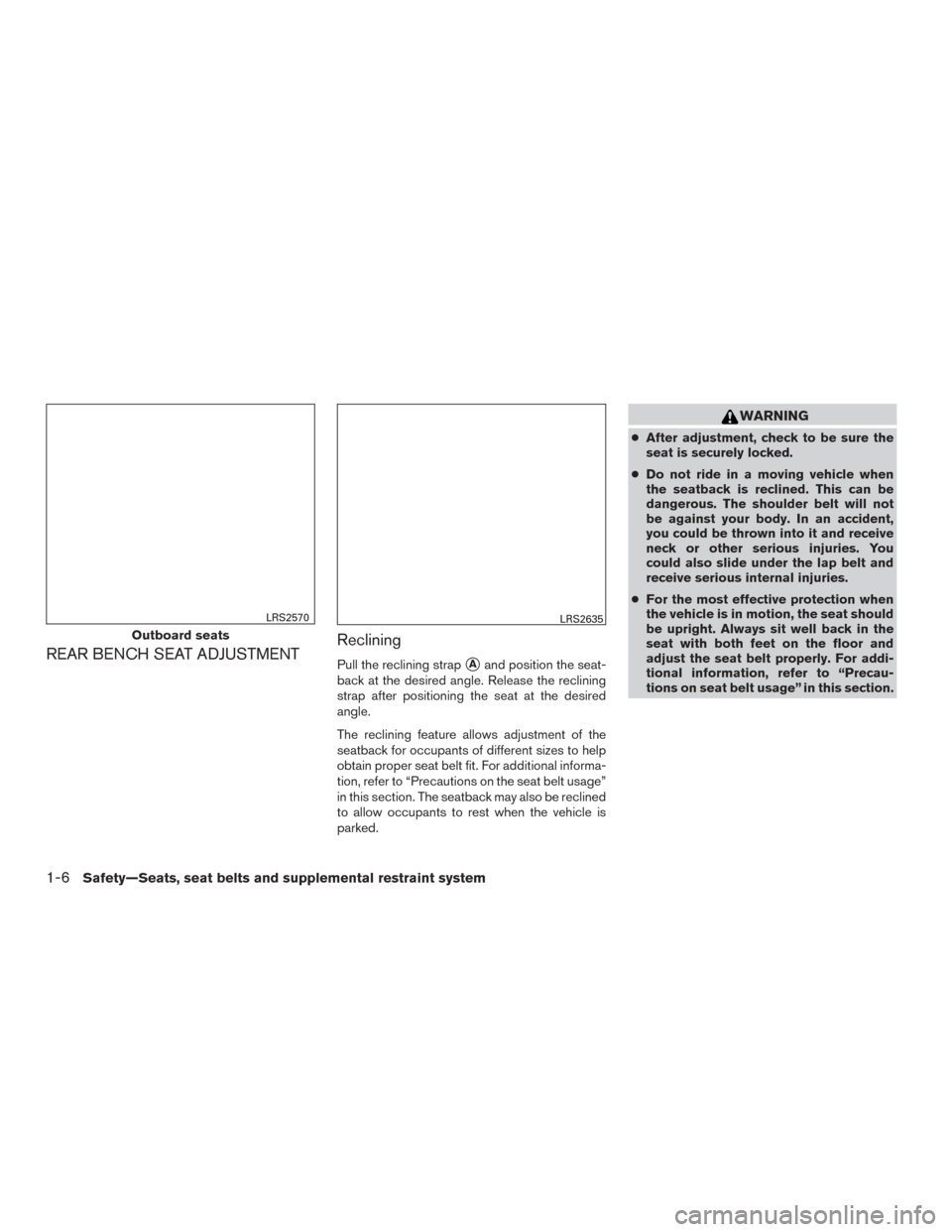
REAR BENCH SEAT ADJUSTMENTRecliningPull the reclining strap�Aand position the seat-
back at the desired angle. Release the reclining
strap after positioning the seat at the desired
angle.
The reclining feature allows adjustment of the
seatback for occupants of different sizes to help
obtain proper seat belt fit. For additional informa-
tion, refer to “Precautions on the seat belt usage”
in this section. The seatback may also be reclined
to allow occupants to rest when the vehicle is
parked.
WARNING
● After adjustment, check to be sure the
seat is securely locked.
● Do not ride in a moving vehicle when
the seatback is reclined. This can be
dangerous. The shoulder belt will not
be against your body. In an accident,
you could be thrown into it and receive
neck or other serious injuries. You
could also slide under the lap belt and
receive serious internal injuries.
● For the most effective protection when
the vehicle is in motion, the seat should
be upright. Always sit well back in the
seat with both feet on the floor and
adjust the seat belt properly. For addi-
tional information, refer to “Precau-
tions on seat belt usage” in this section.
Outboard seats
LRS2570LRS2635
1-6Safety—Seats, seat belts and supplemental restraint system
Page 30 of 424
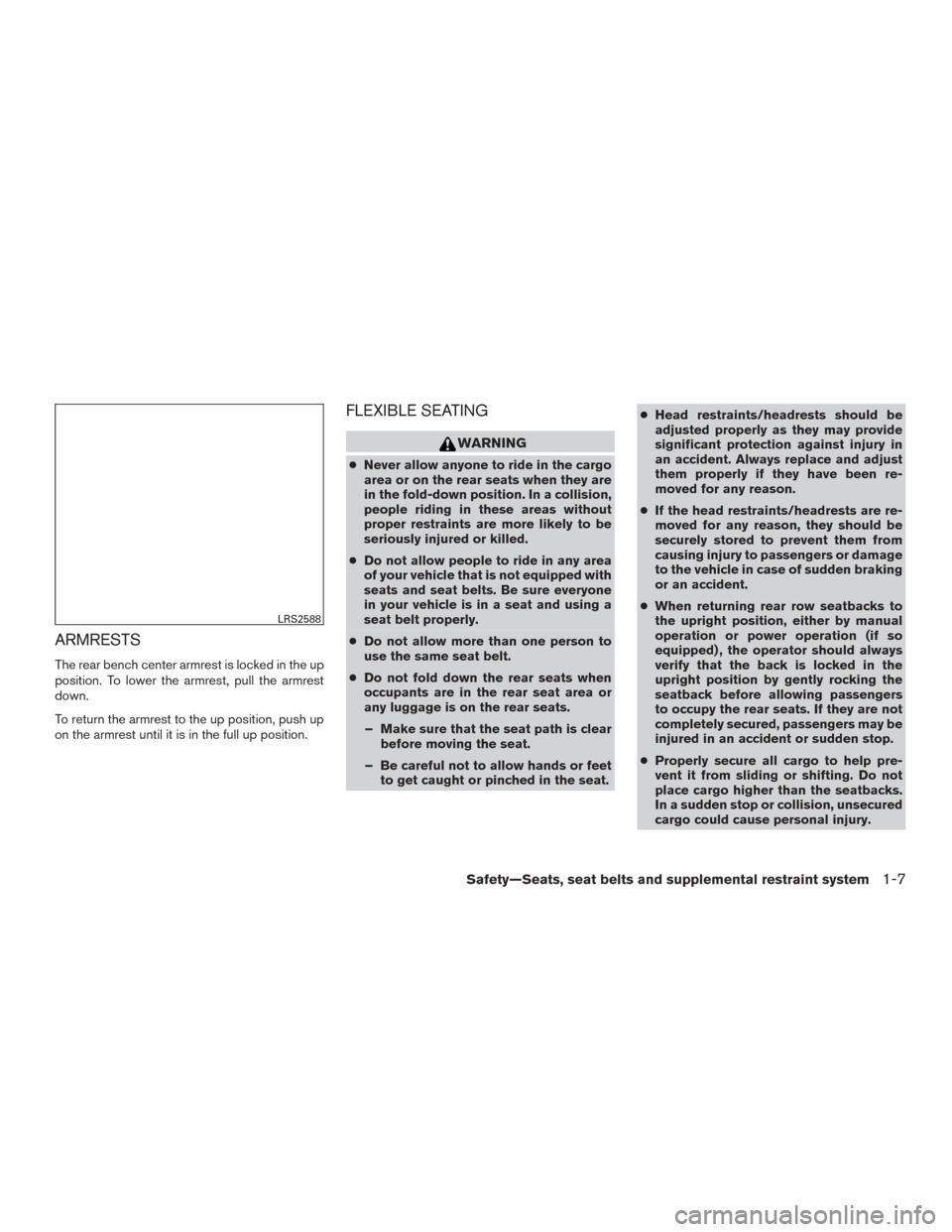
ARMRESTS
The rear bench center armrest is locked in the up
position. To lower the armrest, pull the armrest
down.
To return the armrest to the up position, push up
on the armrest until it is in the full up position.
FLEXIBLE SEATING
WARNING
●Never allow anyone to ride in the cargo
area or on the rear seats when they are
in the fold-down position. In a collision,
people riding in these areas without
proper restraints are more likely to be
seriously injured or killed.
● Do not allow people to ride in any area
of your vehicle that is not equipped with
seats and seat belts. Be sure everyone
in your vehicle is in a seat and using a
seat belt properly.
● Do not allow more than one person to
use the same seat belt.
● Do not fold down the rear seats when
occupants are in the rear seat area or
any luggage is on the rear seats.
– Make sure that the seat path is clear before moving the seat.
– Be careful not to allow hands or feet to get caught or pinched in the seat. ●
Head restraints/headrests should be
adjusted properly as they may provide
significant protection against injury in
an accident. Always replace and adjust
them properly if they have been re-
moved for any reason.
● If the head restraints/headrests are re-
moved for any reason, they should be
securely stored to prevent them from
causing injury to passengers or damage
to the vehicle in case of sudden braking
or an accident.
● When returning rear row seatbacks to
the upright position, either by manual
operation or power operation (if so
equipped) , the operator should always
verify that the back is locked in the
upright position by gently rocking the
seatback before allowing passengers
to occupy the rear seats. If they are not
completely secured, passengers may be
injured in an accident or sudden stop.
● Properly secure all cargo to help pre-
vent it from sliding or shifting. Do not
place cargo higher than the seatbacks.
In a sudden stop or collision, unsecured
cargo could cause personal injury.
LRS2588
Safety—Seats, seat belts and supplemental restraint system1-7